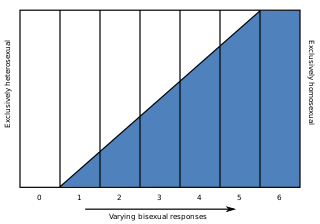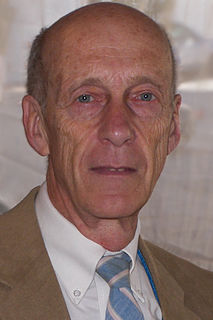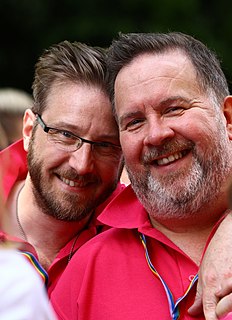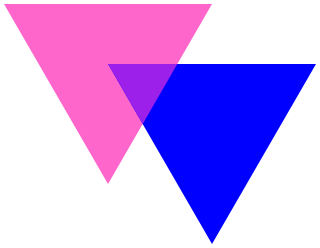
Heterosexuality is romantic attraction, sexual attraction or sexual behavior between people of the opposite sex or gender. As a sexual orientation, heterosexuality is "an enduring pattern of emotional, romantic, and/or sexual attractions" to people of the opposite sex; it "also refers to a person's sense of identity based on those attractions, related behaviors, and membership in a community of others who share those attractions." Someone who is heterosexual is commonly referred to as straight.
Conversion therapy is the pseudoscientific practice of attempting to change an individual's sexual orientation, gender identity, or gender expression to align with heterosexual and cisgender norms. In contrast to mainstream clinical guidance, such practices typically view homosexuality and gender variance as unnatural or unhealthy. There is a scientific consensus that conversion therapy is ineffective at changing a person's sexual orientation and can cause significant, long-term psychological harm.

Sexual orientation is an enduring pattern of romantic or sexual attraction to persons of the opposite sex or gender, the same sex or gender, or to both sexes or more than one gender. These attractions are generally subsumed under heterosexuality, homosexuality, and bisexuality, while asexuality is sometimes identified as the fourth category.

The relationship between biology and sexual orientation is a subject of research. While scientists do not know the exact cause of sexual orientation, they theorize that it is caused by a complex interplay of genetic, hormonal, and environmental influences. Hypotheses for the impact of the post-natal social environment on sexual orientation, however, are weak, especially for males.

The Kinsey scale, also called the Heterosexual–Homosexual Rating Scale, is used in research to describe a person's sexual orientation based on one’s experience or response at a given time. The scale typically ranges from 0, meaning exclusively heterosexual, to a 6, meaning exclusively homosexual. In both the male and female volumes of the Kinsey Reports, an additional grade, listed as "X", indicated "no socio-sexual contacts or reactions" (asexuality). The reports were first published in Sexual Behavior in the Human Male (1948) by Alfred Kinsey, Wardell Pomeroy, and others, and were also prominent in the complementary work Sexual Behavior in the Human Female (1953).
Gender identity is the personal sense of one's own gender. Gender identity can correlate with a person's assigned sex or can differ from it. In most individuals, the various biological determinants of sex are congruent, and consistent with the individual's gender identity. Gender expression typically reflects a person's gender identity, but this is not always the case. While a person may express behaviors, attitudes, and appearances consistent with a particular gender role, such expression may not necessarily reflect their gender identity. The term gender identity was coined by Robert J. Stoller in 1964 and popularized by John Money.

The field of psychology has extensively studied homosexuality as a human sexual orientation. The American Psychiatric Association listed homosexuality in the Diagnostic and Statistical Manual of Mental Disorders (DSM) in 1952, but that classification came under scrutiny in research funded by the National Institute of Mental Health. That research and subsequent studies consistently failed to produce any empirical or scientific basis for regarding homosexuality as anything other than a natural and normal sexual orientation that is a healthy and positive expression of human sexuality. As a result of this scientific research, the American Psychiatric Association declassified homosexuality as a mental disorder in 1973. Upon a thorough review of the scientific data, the American Psychological Association followed in 1975 and also called on all mental health professionals to take the lead in "removing the stigma of mental illness that has long been associated" with homosexuality. In 1993, the National Association of Social Workers adopted the same position as the American Psychiatric Association and the American Psychological Association, in recognition of scientific evidence. The World Health Organization, which listed homosexuality in the ICD-9 in 1977, removed homosexuality from the ICD-10 which was endorsed by the 43rd World Health Assembly on 17 May 1990.
Sexual identity is how one thinks of oneself in terms of to whom one is romantically and/or sexually attracted. Sexual identity may also refer to sexual orientation identity, which is when people identify or dis-identify with a sexual orientation or choose not to identify with a sexual orientation. Sexual identity and sexual behavior are closely related to sexual orientation, but they are distinguished, with identity referring to an individual's conception of themselves, behavior referring to actual sexual acts performed by the individual, and sexual orientation referring to romantic or sexual attractions toward persons of the opposite sex or gender, the same sex or gender, to both sexes or more than one gender, or to no one.

Various non-human animal species exhibit behavior that can be interpreted as homosexual or bisexual. This may include same-sex sexual activity, courtship, affection, pair bonding, and parenting among same-sex animal pairs. Various forms of this are found in every major geographic region and every major animal group. The sexual behavior of non-human animals takes many different forms, even within the same species, though homosexual behavior is best known from social species.

Sexual differentiation is the process of development of the sex differences between males and females from an undifferentiated zygote. Sex determination is often distinct from sex differentiation, sex determination is the designation for the development stage towards either male or female while sex differentiation is the pathway towards the development of the phenotype.
Gregory M. Cochran is an American anthropologist and author who argues that cultural innovation resulted in new and constantly shifting selection pressures for genetic change, thereby accelerating human evolution and divergence between human races. From 2004 to 2015, he was a research associate at the anthropology department at the University of Utah. He is co-author of the book The 10,000 Year Explosion.
The evolution of human intelligence is closely tied to the evolution of the human brain and to the origin of language. The timeline of human evolution spans approximately seven million years, from the separation of the genus Pan until the emergence of behavioral modernity by 50,000 years ago. The first three million years of this timeline concern Sahelanthropus, the following two million concern Australopithecus and the final two million span the history of the genus Homo in the Paleolithic era.

Simon LeVay is a British-American neuroscientist.
INAH-3 is the short form for the third interstitial nucleus of the anterior hypothalamus, and is the sexually dimorphic nucleus of humans. The INAH-3 is significantly larger in males than in females regardless of age and larger in heterosexual males than in homosexual males and heterosexual females.

The Klein Sexual Orientation Grid (KSOG) developed by Fritz Klein attempts to measure sexual orientation by expanding upon the earlier Kinsey scale. Fritz Klein founded the American Institute of Bisexuality in 1998 which is continuing his work by sponsoring bisexual-inclusive sex research, educating the general public on sexuality, and promoting the bisexual community.
Transgender and transsexual people have a gender identity that does not match their assigned sex, often resulting in gender dysphoria. The causes of transsexuality have been studied for decades. The most studied factors are biological, especially brain structure differences in relation to biology and sexual orientation. Environmental factors have also been proposed.

The relationship between the environment and sexual orientation is a subject of research. In the study of sexual orientation, some researchers distinguish environmental influences from hormonal influences, while other researchers include biological influences such as prenatal hormones as part of environmental influences.

A same-sex relationship is a romantic or sexual relationship between people of the same sex. Same-sex marriage refers to the institutionalized recognition of such relationships in the form of a marriage; civil unions may exist in countries where same-sex marriage does not.

Sexual orientation is an enduring pattern of romantic or sexual attraction to persons of the opposite sex or gender, the same sex or gender, or to both sexes or more than one gender, or none of the aforementioned at all. The ultimate causes and mechanisms of sexual orientation development in humans remain unclear and many theories are speculative and controversial. However, advances in neuroscience explain and illustrate characteristics linked to sexual orientation. Studies have explored structural neural-correlates, functional and/or cognitive relationships, and developmental theories relating to sexual orientation in humans.

Bisexuality is romantic attraction, sexual attraction, or sexual behavior toward both males and females, or to more than one gender. It may also be defined to include romantic or sexual attraction to people regardless of their sex or gender identity, which is also known as pansexuality.







